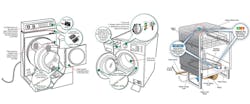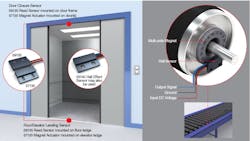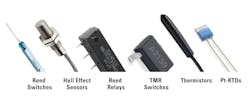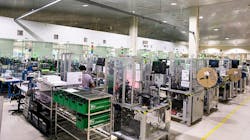Selecting the Right Sensor: A Guide for R&D and Electronics Design Engineers
In the R&D and electronics design world, choosing the ideal sensor for your application goes beyond price and availability. Whether you’re developing smart home appliances, building automation systems, automotive electronics or industrial equipment, sensors are the critical components ensuring your product functions as intended. When selecting a sensor, engineers must think holistically, considering performance, reliability, customization and the supplier’s capabilities.
Following is a breakdown of sensor types, their applications and the key questions every engineer should ask before selecting.
Exploring Sensor Applications
Sensors play a crucial role in various applications, including:
Appliances. From small kitchen gadgets to large home appliances, sensors monitor conditions like temperature, humidity and proximity, ensuring safe and efficient operation.
Building and industrial automation. Sensors enable smart building features such as lighting control, HVAC optimization and security monitoring.
Automotive/electric vehicles (EVs). In modern vehicles, sensors are vital for safety, performance and user experience. They monitor parameters such as speed, tire pressure, battery temperature and proximity for parking assistance. In electric vehicles, sensors play a critical role in battery management and motor control, as well as ensuring efficient energy use, directly impacting vehicle range and safety.
READ MORE: An Overview of Proximity Sensors
Industrial automation. Sensors are the backbone of automated manufacturing and processing environments. They monitor temperature, pressure, flow rates and machine positioning, ensuring precise control and maintaining safety standards. In robotics, sensors enable navigation, collision avoidance and operational efficiency, driving advancements in smart factories.
A Look at Six Essential Sensor Types
Choosing the right sensor requires understanding the different sensor technologies available. Here’s a detailed overview of the six main types used in electronics design.
Magnetic Detection Sensors for Proximity, Positioning and Control
Reed switches. Contain two ferromagnetic blades sealed within a glass tube filled with nitrogen gas to prevent oxidation. The sensitivity of a reed switch depends on the blade stiffness, gap and contact overlap. Activated by a permanent magnet or an electromagnet, reed switches operate without requiring external power, making them ideal for battery-powered devices.
Hall effect sensors. Constructed from semiconductor materials, these sensors generate voltage in response to magnetic fields. They require signal conditioning due to their microvolt/millivolt-level outputs, temperature compensation and electromagnetic compatibility (EMC) protection. Hall effect sensors are suitable for proximity detection and continuous linear or rotary positioning.
Reed relays. These consist of a reed switch and a control coil, providing galvanic isolation between the control circuit and the load. They offer advantages like high insulation resistance, low contact resistance and long life. Their compact size and high magnetic efficiency make them favorable for low coil drive power applications.
TMR switches. Integrating Tunneling Magneto Resistance (TMR) with CMOS technology, TMR switches offer high sensitivity and ultra-low power consumption. They feature on-chip voltage generators for magnetic sensing, amplifiers, comparators and noise-rejecting Schmitt triggers. Internal temperature compensation allows these sensors to operate across a wide supply voltage range.
Temperature Sensors
Thermistors. These are thermally sensitive resistors whose resistance changes predictably with temperature. Negative temperature coefficient (NTC) thermistors decrease resistance as temperature rises, while positive temperature coefficient (PTC) thermistors do the opposite. They provide high accuracy over a narrow range (−50°C to 100°C), making them ideal for precise temperature control applications.
Platinum Resistance Temperature Detectors (Pt-RTDs). Featuring near-linear resistance changes across a broad temperature range (−70°C to 500°C), Pt-RTDs are ideal for applications demanding wide-range temperature measurement and control. Their stability and uniform resistance change rate set them apart from other temperature sensors.
Four Critical Questions for Sensor Selection
When selecting sensors, asking the right questions can lead to better performance, reduced development time and enhanced reliability:
1. Does the supplier offer a wide-ranging product line of sensors and other components?
Partnering with a supplier that produces a variety of sensors means you’re working with a team that has deep expertise in multiple technologies. This approach can be invaluable when customizing sensors to meet specific requirements. Additionally, sourcing various components from a single supplier simplifies the supply chain, helping to streamline operations and reduce vendor management complexity. A supplier with a broad portfolio is more likely to introduce innovative solutions to give your product a competitive edge.
2. Does the supplier offer application assistance?
Technical support from your supplier can save precious development time. Their expertise can help you select a suitable sensor and ensure you consider essential parameters such as temperature, vibration and electrical noise susceptibility. Supplier application engineers can guide you through installation and usage nuances, potentially identifying issues before they become costly problems in the field.
3. Does the supplier provide custom engineering?
Your design may have unique requirements, such as size constraints, enhanced sensitivity or specific connector types. A supplier with custom engineering capabilities can address these needs by creating a sensor tailored to your application. Suppliers focused solely on standard products may limit your design flexibility and hinder your project’s long-term success. Look for manufacturers using advanced tools, such as simulation software and 3D CAD design, to accommodate custom sensor requests efficiently.
READ MORE: Sensors That Promote More Efficient Industrial Workplaces
4. Does the supplier have the capacity to manage your order requirements?
Supply chain disruptions and long lead times can significantly impact revenue. Ensure your supplier has the manufacturing capacity to meet both your forecasted needs and unexpected large orders. This capability is crucial for maintaining product availability and meeting market demands promptly.
The Advantages of a Capable Sensor Supplier
Working with a supplier that meets these critical criteria may mean a higher upfront cost for the sensor. However, the benefits—such as reduced development time, lower warranty expenses, enhanced product reliability and higher customer satisfaction—can lead to substantial long-term savings. Supplier selection is as vital as sensor selection itself, ultimately contributing to the success of your product in the market.
Final Thoughts
When choosing sensors, price and delivery time are essential, but technical capabilities, customization options, application support and supply chain management can significantly impact the overall product performance and market competitiveness. Make informed decisions to ensure your sensors meet and exceed your project’s requirements.
About the Author
Barry Brents
Field Application Engineer, Littelfuse
Barry Brents is a field application engineer at Littelfuse. He is a former U.S. Navy nuclear submarine officer and a licensed professional electrical engineer in Colorado and California. He has been with Littelfuse for 35 years (including acquisitions), and his current responsibilities include technical support, design assistance and training for customers and salespeople. He received his B.S.E.E. from Texas Tech University.





